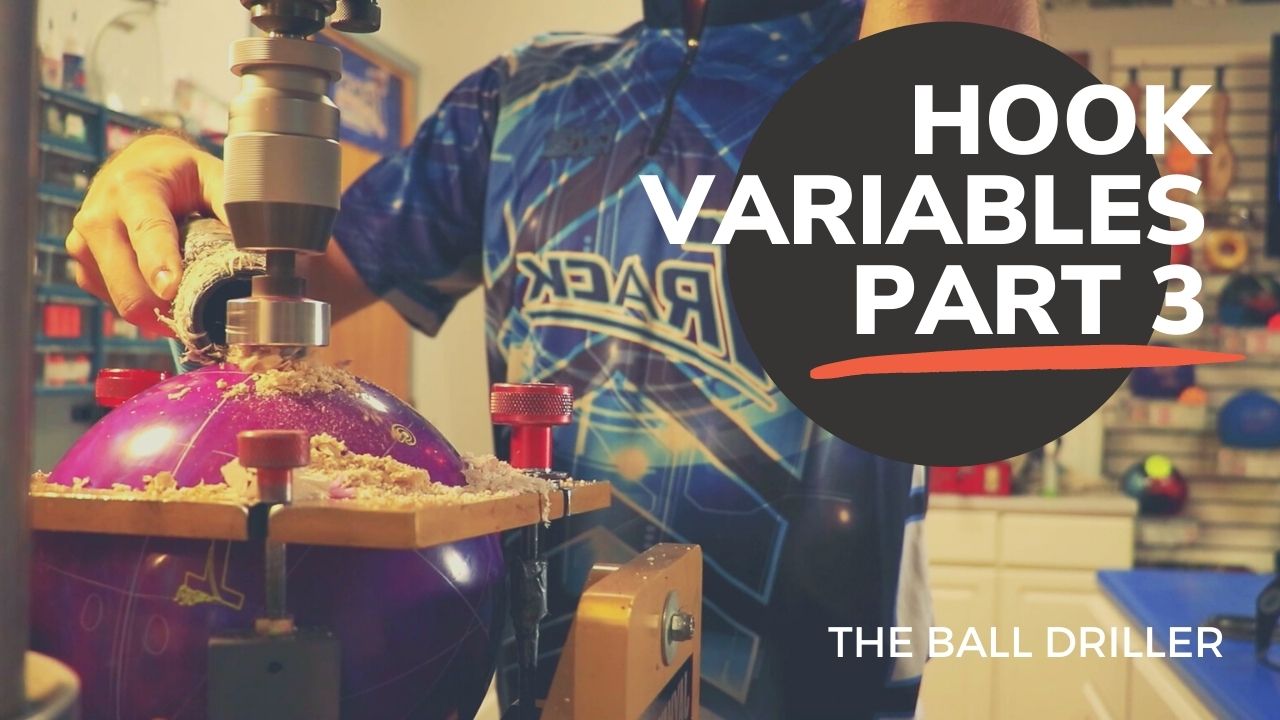FREE SHIPPING ON ORDERS OVER $30
Hook Variables: Part 3 | The Ball Driller

In the previous two articles we examined the variables that determine how much a bowling ball hooks, that are controlled by the bowler, and the type of ball you purchase. This time we will look at how the ball driller can affect ball performance. The way your ball is drilled obviously will have an affect on your bowling ball reaction, but even the best ball driller cannot do miracles with pin placement if you choose the wrong ball for the specific task. And remember the most important factor of all is you, the bowler.
So, lets assume you have had your game analyzed and understand your player profile. And you have made the proper ball selection to suit your style. Now you need to have the holes drilled in the proper place to get the desired reaction. The most important piece of information your certified pro shop operator will need to know to map out your bowling ball is your positive axis point (PAP). Your driller will measure this by watching you bowl or looking at an old ball with a track worn in it. The layout of the bowling ball will be referenced off this number and this is a personal number specific to each bowler. A common mistake made by bowlers is having the pin placement on their new ball done the same as Johnny Hotshot’s ball. Everybody is different and must be treated that way. Now, you may know someone who has a similar release and can use that person as a reference, but don’t copy someone just because they bowled well last night in league. Your ball driller will understand that your release variables – axis tilt, axis of rotation, speed, and rev rate – will be factored in when determining your pin placement.
Every ball has at least one pin marked on the outside. This is an extension of the weight block and gives the ball driller a reference point. Balls with asymmetric shaped weight blocks (mass bias) will also have a second (minor) pin marked. Your ball driller will determine where to place the pin(s) and measure the appropriate distance from your PAP. Let’s look at the main pin first.
When you place the pin directly on your PAP you will get a very smooth rolling ball because the weight block is not tumbling. Unfortunately, a ball drilled this way usually does not hit very hard so most people do not use this pattern. If you place the pin 6 ¾ inches from you PAP, you will be standing the weight block up so it will tumble in an end over end pattern. This layout also will not hook much because there will be little or no track flare. Track flare is created by moving the pin to an unstable position which makes the weight block wobble inside the ball in an attempt to stabilize itself. This makes the ball hook more and stronger on the back end. The strongest position for the pin in most balls is 3 3/8 inches from your PAP. This will give you the maximum flare. By moving the pin close to your PAP or closer to 6 ¾ inches away from your PAP, you will reduce the flare and cut down on your hook. Most bowlers buy a ball for the amount of flare potential, as determined by the ball’s differential, so generally it is best to drill the ball with maximum flare. If you do not need this much flare you probably should choose a different ball. But keep in mind that you can vary the flare potential by pin placement.
Another critical concern for pin placement is how high the pin is above the midline of your grip. As you move the pin away from the midline – above the fingers, for example – you are increasing the R/G of the weight block. We discussed R/G in part 2 from last week. So, you can have the same pin distance but with a high pin or low pin to get a different reaction. Radical shifts in pin placement can also create other problems like the ball tracking over fingerholes and should be considered before drilling.
The minor pin in asymmetric balls is another factor to be considered in drilling. Most manufacturers agree that a mass bias less than .010 will not create a significant influence in ball reaction. The placement of the minor pin is not as critical as the major pin but does alter the breakpoint of your ball. The overall strength of the mass bias will determine the actual impact.
Most manufacturers include a ball layout spec sheet that will give recommendations on how to layout the ball for a specific reaction based on your release. These spec sheets are good reference guides, but you must be honest and realistic about your release.
One final word of advice about layouts. There are many variables in pin placement and static balance that affect ball reaction, which may make the process seem complicated. Do not get caught up in minor changes because they will not be significant enough to matter. Unless you are a serious tournament bowler with more than 4 bowling balls, you probably are better off keeping your drill patterns simple. Changing your pin position will not correct a poor release. Remember the bowler comes first in the ball reaction equation.




![[VIDEO] Brunswick Prism Warp | Ball Review](https://bowlingworld.biz/media/mageplaza/blog/post/resize/400x/b/r/brunswick-prism-warp-ball-review-video.png)
![[VIDEO] Radical Results | Ball Review](https://bowlingworld.biz/media/mageplaza/blog/post/resize/400x/r/a/radical-results-ball-review-video.png)
![[VIDEO] Track In2ition | Ball Review](https://bowlingworld.biz/media/mageplaza/blog/post/resize/400x/t/r/track-in2ition-ball-review-video.png)
![[VIDEO] Columbia 300 Baller | Ball Review](https://bowlingworld.biz/media/mageplaza/blog/post/resize/400x/c/o/columbia-300-baller-ball-review.png)










Comments